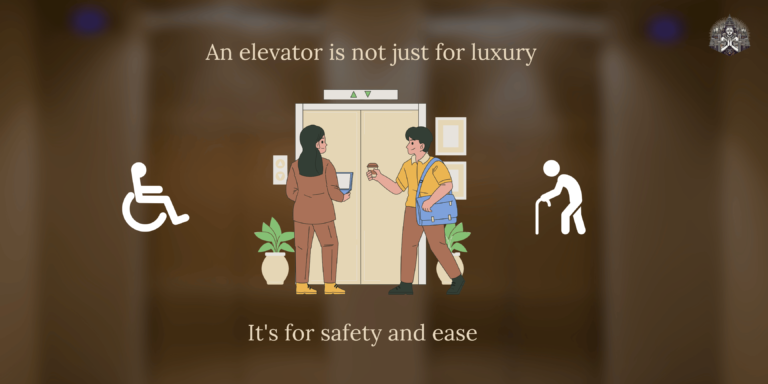Home elevators have become a popular addition in modern homes. With increased accessibility and ease of use, they are no longer limited to luxury properties. Let’s dive into the benefits, types, costs, and installation considerations for adding a home elevator.
 Many models cater specifically to elderly users, offering safety features like backup batteries, emergency call buttons, and handrails. With these features, elderly individuals can enjoy the confidence of safe and simple movement around their home.
Many models cater specifically to elderly users, offering safety features like backup batteries, emergency call buttons, and handrails. With these features, elderly individuals can enjoy the confidence of safe and simple movement around their home.
Why Get a Home Elevator? Exploring the Benefits
Why should you install a home elevator? These additions offer a range of benefits beyond mere convenience. Here are a few key reasons why a home elevator may be a perfect fit for your home.Improved Accessibility
A home elevator can make life easier for everyone, especially those with mobility issues. Elderly family members or anyone with physical limitations can move between floors safely and comfortably. This upgrade allows homeowners to “age in place,” staying in their multi-level homes without worrying about the hassle of stairs.Increased Property Value
A home elevator can boost your property’s value. Buyers often appreciate the convenience and added accessibility, which can make your home stand out in a competitive market.Space-Saving Solution
Stairways take up a lot of space. In contrast, modern home elevators use minimal room, with some models fitting into spaces as small as a closet. This helps you maximize usable square footage, especially if you choose a compact model like a pneumatic or shaftless elevator.Types of Home Elevators: Which One Suits Your House Best?
With several types of home elevators to choose from, it’s essential to understand each type to find the best match for your needs and home layout.Hydraulic Elevators
Hydraulic elevators are popular for residential use. These elevators use hydraulic power to move up and down, typically requiring a machine room. Though a bit more costly, they are smooth, quiet, and highly durable. They are also ideal for carrying heavy loads, which makes them perfect for larger households.Pneumatic Vacuum Elevators
If you want a modern look without complex installation, consider a pneumatic elevator. These elevators work by using air pressure to move between floors. They’re a space-saving option, often fitting in compact areas without needing a machine room.Shaftless Elevators
Shaftless elevators are perfect for homes that need only two levels of access. They are compact, easy to install, and ideal for retrofitting into existing homes. However, they may not support heavy loads, so they work best in smaller households.Cable-Driven Elevators
Cable-driven elevators operate similarly to commercial elevators, using cables to lift and lower the car. They require a dedicated machine room, which can limit their placement options. They provide a smooth ride and are reliable for multi-level homes.Home Elevators for the Elderly: A Practical Solution for Independence
A home elevator can be a game-changer for elderly family members. It enhances mobility and independence, helping them move between floors effortlessly. Additionally, elevators reduce the risk of falls, a common concern for elderly people using stairs. Many models cater specifically to elderly users, offering safety features like backup batteries, emergency call buttons, and handrails. With these features, elderly individuals can enjoy the confidence of safe and simple movement around their home.
Many models cater specifically to elderly users, offering safety features like backup batteries, emergency call buttons, and handrails. With these features, elderly individuals can enjoy the confidence of safe and simple movement around their home.
What is the Average Cost of a Home Elevator? Budgeting Tips
Home elevator costs can vary widely depending on the type, features, and complexity of the installation. Here’s a look at the pricing and what you can expect when budgeting for a home elevator in Nepal.Cost Range in Nepal
In Nepal, the average cost of a basic home elevator ranges from NPR 10,00,000 to NPR 35,00,000. Hydraulic elevators, known for their durability and smoothness, typically cost more, from around NPR 25,00,000 to NPR 50,00,000. Meanwhile, shaftless and pneumatic models can be on the lower end, depending on features and materials.Additional Cost Considerations
Aside from the base cost of the elevator, consider expenses for installation, permits, and any needed structural adjustments to your home. Maintenance is also an ongoing cost to keep your elevator running smoothly. Pro Tip: Choose an elevator with low maintenance requirements to help reduce long-term costs. Following chart shows the comparison between prices of Different kind of elevator (rate in NPR):| Elevator Type | Estimated Price Range (NPR) |
|---|---|
| Hydraulic Elevator | 25,00,000 – 50,00,000 |
| Pneumatic Elevator | 15,00,000 – 30,00,000 |
| Shaftless Elevator | 10,00,000 – 20,00,000 |
| Cable-driven Elevator | 20,00,000 – 40,00,000 |
Choosing the Right Elevator Company: Finding the Best Fit for Your Home
Selecting a reputable elevator company ensures a safe and smooth installation process. Here are some tips on how to choose the right provider:- Research and Reviews: Look for customer reviews online and ask for recommendations from friends or family who have installed a home elevator.
- Experience and Certifications: Work with companies that have solid experience and the necessary certifications. Companies familiar with Nepalese building codes can ensure compliance and safety.
- Maintenance Services: Elevators require regular maintenance. Choose a company that offers affordable and reliable servicing plans.
- Warranty and Support: A good company provides a warranty, so you can count on their support for any repairs needed in the first few years.


